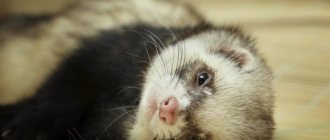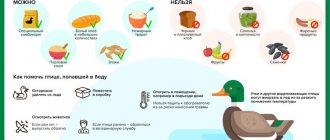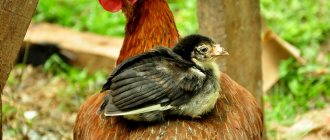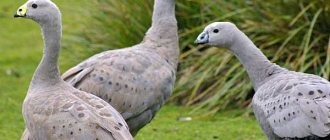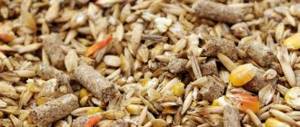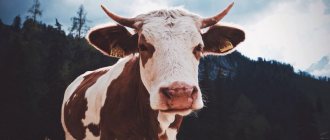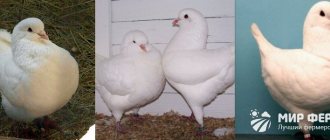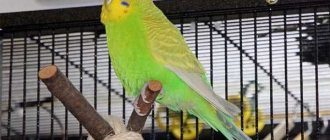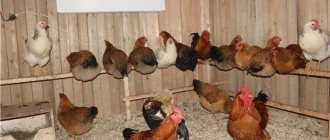Infectious laryngotracheitis of birds
Infectious laryngotracheitis (ILP) is an acute infectious respiratory disease of gallinaceous birds characterized by catarrhal-hemorrhagic inflammation of the mucous membranes of the trachea, nasal cavity, conjunctiva and accompanied by difficulty breathing, wheezing and coughing.
Historical reference . The disease was first described in 1925. in the USA May and Titsler called tracheolaryngitis. For a long time, infectious laryngocheitis in birds was not differentiated from infectious bronchitis.
Later, Bigs, Silk and Hawn proved the independence of these two diseases, and since 1931 the disease began to be called “infectious laryngotracheitis.”
In the USSR, this disease was established in 1932. R.T. Batakov. In 1951
S.T. Shchennikov prepared a vaccine using chicken embryos. Infectious laryngotracheitis of birds is common in the USA, Canada, South America, Europe, Africa, Australia, and Asia. In Russia, ILP is registered mainly in farms with continuous industrial poultry keeping.
Economic damage during ILP consists of poultry waste, mortality reaches 15-50%, a decrease in egg production in sick and recovered laying hens by 10-30%, and weight gain. Costs of measures to control the infection. Premature culling of sick birds causes great damage.
Etiology . The causative agent of ILP is a virus that belongs to the Herpesviridae family. The virus is found in large quantities in the exudate and epithelial tissues of the upper respiratory tract; in smaller quantities it can be found in the liver and spleen. The data on the size of the virus is contradictory: some researchers consider it to be from 30 to 100 nµ, others - from 150 to 240 nµ. Virions are spherical in shape. Virions have three structural components: a core (nucleoid), a capsid with capsomeres, and an envelope. The particle size depends on the location of the virus; for example, it is larger in the cytoplasm than in the nucleus of the affected cell. Viruses pass through Berkefeld W and N filters, E.K. Seitz plates. and membrane ultrafilters with pores from 0.7 to 0.9 nµ. The causative agent of I.L.P. is constantly found in tracheal mucus, exudate of the larynx, conjunctiva, and less often in the blood, spleen and liver of sick chickens. The serum of recovered ILP contains specific virus-neutralizing antibodies. Researchers distinguish between virulent and weakly virulent viral strains that have no antigenic differences. The virus is stable in the external environment, especially at sub-zero temperatures. In frozen carcasses, the virus persists for more than 19 months, in corpses buried in the ground at a depth of 120 cm in summer - up to 47 days, in corpses on the surface of the earth (April-May) - over 30 days, dried - 359 days. At a temperature of 37°C, the eggshell dies after 12 hours, when heated to 55°C - after 2 hours, when boiling - immediately. The virus persists in the poultry house for no more than 6-9 days. Sunlight kills the virus within 7 hours. The virus is not resistant to disinfectants; a 3% sodium hydroxide solution and a 3% cresol solution inactivate it after 30 seconds.
Epizootological data . Under natural conditions to the I.L.K. virus. Chickens, pheasants, peacocks and turkeys are susceptible. Young chickens aged 5 months to a year are more susceptible, but chickens from 20-35 days of age can get sick.
I.L.K. There is some seasonality, which is associated with changes in weather conditions, low temperature, high humidity in the premises and the deterioration of keeping birds in the winter in private household plots and peasant farms. Additionally, low temperatures contribute to longer survival of the pathogen in the external environment.
The disease in young hens and chickens occurs after the birds are transferred to other premises with worse living conditions (high humidity, insufficient ventilation, inadequate feeding, etc.). Chicks hatched from complete hatching eggs are resistant to I.L.C. in the first days of life.
In dysfunctional large poultry farms with a continuous poultry growing system, the disease often becomes stationary. The stationary nature of the disease on the farm is explained by the long-term carriage of the virus in recovered birds (up to two years). Virus carriage in birds vaccinated with live vaccines continues for at least 90 days.
The nature of the course of ILC is directly influenced by the conditions of keeping and feeding the birds at the time the infection is introduced into the poultry house: dampness in the room, poor ventilation, overcrowding and unbalanced feeding rations.
Epizootic strains of viruses differ in virulence properties, the degree of which can vary significantly.
The main source of infection entering the farm is sick birds and virus carriers. Transmission factors include food, water, objects, shoes and clothing contaminated with secretions of a sick bird, etc. Infection occurs aerogenously. When a sick bird coughs, it releases small droplets of exudate containing the virus into the air. Wild birds and rats can be mechanical carriers of the disease.
If the infected I.L.K. do not introduce susceptible birds into the flock. Then, under good feeding and maintenance conditions, the spread of the disease may stop after 2-4 weeks.
Pathogenesis . After contact with damaged mucous membranes of the larynx, trachea, and cloaca, the virus penetrates epithelial cells with the formation of intranuclear inclusions and causes an acute inflammatory process. The virus, having a tropism for the epithelial tissues of the respiratory tract, begins to actively multiply in them, causing swelling and lympholeukocyte infiltration. In the initial stage of the disease, we find mucous exudate in the lumen of the trachea; later, as a result of hemorrhages, blood and fibrin are mixed into the exudate. From epithelial tissues, the virus spreads through the bloodstream to all organs of the bird. However, pathological changes usually do not occur in them. With laryngotracheitis, viremia is short-lived; the virus remains in the epithelial tissues of the trachea and larynx for a long time.
The formation of caseous plugs in the tracheal lumen indicates the accession of opportunistic microflora to the main process. In such cases, virus isolation can be difficult. Cellular detritus, fibrin and blood cells form a clot that clogs the lumen of the trachea and causes clinical symptoms of suffocation and death of the bird.
Symptoms and course of the disease . The incubation period, depending on the virulence and amount of virus that has entered the body, as well as the resistance of the bird to the disease, ranges from 2 to 30 days. The first clinical symptoms of the disease in poultry when the virus enters the intratracheal route appear after 3-7 days. The course of the disease with I.L.P. can be acute, subacute, chronic and asymptomatic. In this case, in a sick bird, three forms of the disease are distinguished: laryngotracheal, conjunctival and atypical.
In the acute course of the laryngo-tracheal form, as a rule, individual chickens first become ill, and after 7-10 days all the birds of the disadvantaged group become ill. In a sick bird we note general depression and lethargy; the appetite disappears, they refuse to feed, the bird becomes sedentary, sits with its eyes closed. When listening carefully in the evening to a calmly sitting bird, we hear a variety of whistling, croaking and wheezing sounds. Blockage of the larynx and trachea with exudate leads to breathing problems. The bird breathes through an open beak, the act of inhalation and exhalation is difficult. When palpated in the area of the larynx and tracheal tube, it causes coughing fits in the bird. The bird coughs up exudate, which sometimes contains blood. When examining the open beak, hyperemia and swelling of the mucous membrane of the larynx and trachea, sometimes with hemorrhages, are noticeable. In prolonged cases, curd-fibrinous deposits accumulate around the larynx. A sick bird stops egg production. Mortality in acute laryngotracheitis is often 10-60%, depending on unfavorable feeding and maintenance factors.
Subacute course of I.L.P. lasts 2-3 weeks, clinical signs are less pronounced. The bird recovers or the disease becomes chronic (over a month) and is characterized by periodic improvements in the bird’s condition. The bird has a cough, difficulty breathing, anemic comb and earrings, when examining the pharynx and larynx, fibrinous, easily removable grayish deposits are found, egg laying is reduced.
The conjunctival form of the disease, which usually proceeds chronically, more often affects chickens with an intensive flow rearing system, when birds of different ages are overinfected. Initially, individual chickens of 10-15 days of age become ill, and later the entire batch of birds is affected. The main clinical signs are hyperemia of the mucous membranes of the eye, deformation of the palpebral fissure (narrowing of the palpebral fissure, protrusion of the 3rd eyelid in the inner corner of the eye and sinusitis), swelling of the eyelids, photophobia, lacrimation. During this period of the disease, the body temperature of chickens is increased by 1-2°. The released exudate sticks the eyelids together, hemorrhages are noticeable on the mucous membrane of the conjunctiva, fibrinous masses accumulate under the third eyelid, keratitis and panophthalmia occur with loss of vision. The process involves the infraorbital sinus and the mucous membranes of the nasal cavity.
The conjunctival form of infectious laryngotracheitis lasts from 20 days to 2-3 months and leads to exhaustion of chickens and their increased rejection. This form of the disease can affect 5-90% of chickens up to 60 days of age. The disease is most severe when poultry is kept in rooms with high humidity and high ammonia content.
The atypical form is detected by serological tests of poultry blood serum. Often infectious laryngotracheitis occurs in association with other infections, for example respiratory mycoplasmosis, colisepticemia.
Pathological changes . In the laryngo-tracheal form, changes are found in the larynx and trachea, the mucous membrane of which is highly hyperemic, swollen, with minor hemorrhages. The lumen of the trachea contains varying amounts of mucous, serous or bloody exudate. With prolonged flow in the lumen of the larynx, we find a caseous plug, often clogging the entire lumen. On the mucous membrane of the oral cavity on one or both sides of the root of the tongue and on its frenulum we sometimes find caseous-fibrinous small, easily removable deposits; less commonly, caseous lesions in the lungs. Sometimes we find catarrhal-hemorrhagic inflammation of the cloaca, less often of individual sections of the small intestines. A compacted curd-purulent mass is often observed in the bursa of Fabricius. In the conjunctival form, the mucous membrane of the eyelids of one or both eyes is hyperemic, swollen, and in some cases the cornea and eyeball are affected. In the early stages of I.L.P. histological examination of the epithelial cells of the affected tracheal mucosa reveals characteristic intranuclear inclusions (acidophilus bodies), cellular infiltration and desquamation of cells of the tracheal mucosa.
Diagnosis . We diagnose on the basis of epizootic, clinical, pathological data, as well as the results of laboratory tests (detection of intranuclear inclusions in the tracheal epithelium, virus there using fluorescent antibodies, RDP, RN). In case of an atypical course of the disease, laboratory tests are carried out. After excluding bacterial infections, a bioassay is performed, the virus is isolated, a neutralization reaction is performed on embryos, a double diffusion precipitation reaction in an agar gel is performed, and histological sections are examined for the presence of round or sausage-shaped intranuclear inclusions surrounded by clearly visible rims.
If there is a suspicion of ILP disease in birds, clinically sick birds in the initial stage of the disease in the amount of 4-5 birds and fresh carcasses are sent to the veterinary laboratory for testing.
Differential diagnosis . I.L.P. must be distinguished from pseudoplague, respiratory mycoplasmosis, smallpox, pasteurellosis and vitamin A deficiency, contagious runny nose, infectious bronchitis. Bird pseudoplague is distinguished by its epizootic course, characteristic lesions (ring of hemorrhages) of the mucous membrane of the glandular stomach, and ulcers on the intestinal mucosa.
Respiratory mycoplasmosis spreads slowly, affects the air sacs, and deaths are rare.
To exclude smallpox, the bird is clinically examined for the presence of smallpox lesions. Diphtheroid and conjunctival forms of smallpox, due to the similarity of clinical symptoms, can be differentiated by isolating and typing the virus.
A-vitaminosis is characterized by easily removable plaque in the oral cavity and the absence of asthma attacks.
Immunity and immunization . After recovering from I.L.K. chickens acquire long-term immunity to subsequent infection. The mechanism of its formation is determined by cellular and humoral factors. After infection, antibodies appear within 14-20 days and remain in the blood serum for 2-3 months. Duration of immunity is 5-7 months. Naturally weakened and attenuated strains are used for immunization. Currently, VNIIBBP and VNIIVViM vaccines are used in Russia and the countries of the customs union. These vaccines are used by rubbing into the mucous membrane of the cloaca, instilling into the conjunctiva and by aerosol. When carrying out aerosol vaccination, immunity develops after 4-5 days and lasts up to a year. Poultry farms widely use the embryo-virus vaccine from the NT clone of the TsNIIPP strain, which is currently less reactogenic.
Treatment . At this point in time, there are no specific effective therapeutic agents for ILC. In order to reduce the mortality of poultry and prevent a decrease in egg production, antibiotics are used in combination with furozolidone and trivitamin, dioxidin (indoors), nigras (in the form of an aerosol).
Prevention and control measures . To prevent I.L.C. Poultry owners must strictly implement measures to protect the farm from the introduction of pathogens of infectious diseases. Supply your farm with eggs intended for incubation and one-day-old chicks only from farms that are free from ILC. It is necessary to carry out veterinary and sanitary measures for the proper care, maintenance and feeding of poultry, especially when kept in cages without walking. Disinfect indoor air in the presence of poultry using drugs that promote partial inactivation of the virus and bacterial microflora in the upper respiratory tract. It is necessary to keep birds separately depending on their age. No unauthorized persons should be allowed into the farm territory. When a bird disease with laryngotracheitis is established in accordance with the order of the Ministry of Agriculture of the Russian Federation No. 476 of December 19, 2011 “On approval of the list of infectious, including especially dangerous animal diseases for which restrictive measures (quarantine) can be established” by a decree of the Regional Governor for a farm (farm, poultry house) quarantine is imposed and restrictions are introduced. Activities in troubled farms are carried out in accordance with temporary instructions on measures for the prevention and elimination of infectious laryngotracheitis in birds. Approved by the Main Veterinary Directorate of the State Agricultural Industry of the USSR on April 1, 1983. Under quarantine conditions it is prohibited:
- movement of poultry within a farm (farm, department, zone) during a disease outbreak;
- importation into and exportation of birds of all ages into a disadvantaged farm (farm, department, zone);
- export of hatching eggs to other farms;
- use of eggs from dysfunctional poultry houses for on-farm incubation;
- removal of feed, equipment and inventory from unfavorable production premises and from the territory of unfavorable farms (farms, departments, zones);
- importation and storage of eggs received in a disadvantaged department, zone, or egg warehouse of the farm;
- entry into and exit of people from the territory of a dysfunctional farm without complete sanitary treatment and change of clothes and shoes.
During periods of economic distress, it is permitted to:
- removal of food eggs from an unfavorable department (zone, farm) after disinfection to the distribution network within the region;
- incubation of eggs for on-farm purposes from birds in safe poultry houses after aerosol disinfection with a formaldehyde solution according to the scheme: the first time - no later than 1.5-2 hours after laying, the second - packed in containers in a special vehicle or disinfection chamber of the hatchery, the third - after sorting before placing in the incubator , fourth - 6 hours after the start of incubation;
- delivery of hatching eggs and day-old chicks to a safe department, farming area;
- in the absence of a slaughterhouse on the farm, export to poultry and meat processing enterprises of healthy poultry houses subject to scheduled slaughter, with the permission of the state veterinary supervision authorities of the region (region, republic, which does not have a regional division).
When ILP occurs for the first time on a farm, in order to prevent the spread of the disease, all the birds in the unsafe poultry house are killed. At the same time, all necessary veterinary and sanitary measures are carried out to ensure the destruction of the pathogen in the external environment. If the disease spreads to other poultry houses, a thorough culling is carried out and the sick and weak birds are slaughtered at the sanitary slaughterhouse of the farm (farm, department, zone).
All clinically healthy birds are immunized with the ILP vaccine in accordance with the instructions for its use.
The farm is improving the feeding and maintenance of birds, and introducing anti-stress drugs (supplements) into the diet.
Each poultry house is assigned maintenance personnel who are provided with special clothing, safety shoes, and disinfectants. Poultry slaughter is carried out in compliance with veterinary and sanitary rules under the supervision of a veterinary specialist, followed by disinfection of slaughter sites, inventory and equipment.
If it is necessary to slaughter a large batch of poultry from a dysfunctional poultry house and it is impossible to slaughter it on the farm within 2 days with the permission of the regional veterinary department, etc. It is allowed to export clinically healthy poultry to meat processing plants in compliance with the relevant veterinary and sanitary rules. Down and feathers obtained from the slaughter of birds from unfavorable poultry houses are disinfected according to clause 3.6. instructions.
Containers and boxes are subject to mandatory cleaning and disinfection after transporting poultry for slaughter, meat containers, as well as containers, cardboard spacers, boxes and other containers used for transporting eggs.
During periods of trouble, the farm (department) on the ILC carries out thorough mechanical cleaning, as well as current and final disinfection of troubled poultry houses, hatcheries, utility rooms, inventory and equipment, production areas, means of transport and other objects, as well as disinfestation and deratization in the order and time frame , provided for by the current Instructions for veterinary disinfection, disinfestation, disinfestation and deratization.
Manure and deep litter are transported to a manure storage facility for biothermal disinfection.
Restrictions on ILC in a farm (department, zone) are lifted 2 months after the last case of slaughter of sick and recovered birds and the completion of final veterinary and sanitary measures.
INFECTIOUS LARYNGOTRACHEITIS OF BIRDS(Laryngotracheitis infectiosa avium), a contagious viral disease characterized by hemorrhagic. inflammation of the pharynx and trachea. The disease is widespread in the USA, Canada, Australia, Germany, East Germany, Italy, India and other countries; registered in the USSR. Mortality averages 15%.
Etiology. The causative agent is a virus of the family. Herpesviridae. Virions are 180-250 nm in size, spherical. forms. The virus is well cultivated in chicken embryos when infected on the chorioallantoic membrane, in cell cultures of the chicken embryo, causing cytopathic. Effect. Serum of recovered I. l. n. and hyperimmune birds contains specific. virus neutralizing antibodies. There are virulent and weakly virulent viral strains, between which there are no antigenic differences. Sunlight kills the virus after 7 hours; on the surface of eggs it is inactivated at t
60°C for 2 minutes, in the trachea of corpses it is stored at
t
4-10°C for 30-60 days, at
t
8°C, -10°C - more than 370 days, in a dried state under vacuum - up to 2 years. 1% solution of alkali [alkali], 3% solution of cresol inactivate the virus in 30 seconds.
Epizootology. Most susceptible to I. l. n. chickens (aged 5 months - 1 year) and pheasants. Turkeys, ducks, and pigeons rarely get sick. The source of the infectious agent is sick and recovered birds, which remain virus carriers for a long time. Transmission factors are food and water, equipment. The virus can be carried by service personnel. The ways of penetration of the virus are ch. arr. nasal passages, conjunctiva and trachea. The disease manifests itself in the form of epizootics. The emergence of I. l. etc. are promoted by room humidity, overcrowding of poultry and inadequate feeding. Birds that have recovered from the disease acquire lasting immunity, which is transmitted [transmitted] to offspring through eggs.
Symptoms and course. Incubation period - 6—
15 days
There are acute, subacute and chronic. course of the disease. In acute cases (laryngotracheal form), the birds are depressed, refuse food, and sit “with their eyes closed.” Breathing is difficult, the beak is open; birds make peculiar croaking sounds. Fibrinous deposits are visible in the larynx, which can cause asphyxia. Tearing and discharge from the nasal openings are also observed. The subacute course is also characterized by lesions of the respiratory organs to a lesser extent. For chronic During the course of the disease, conjunctivitis is observed, as well as swelling [swelling] of the eyelids, lacrimation, photophobia, hemorrhages in the third eyelid, accumulation of caseous mass in the conjunctival sac, keratitis, and panophthalmia. I.l. p. is often complicated by mycoplasmosis
and other diseases.
Pathological changes. Catarrhal or fibrinous-hemorrhagic is typical. tracheitis (Fig.). Sometimes hemorrhages are found in the mucous membrane of the nasal passages and sinuses, catarrhal-hemorrhagic. enteritis, cloacitis, sinusitis, bronchitis, bronchopneumonia. With histol. The study reveals cellular infiltration and desquamation of cells in the tracheal mucosa.
Diseases of the respiratory system of birds
02.06.2020
Typical symptoms of respiratory disease in poultry include watery eyes, swollen sinuses, whistling airways, sneezing, squealing and difficulty breathing. In this article we will look at different types of respiratory system diseases.
Nematodes - Gapeworm (Syngamus Trachea)
Hookworms (Syngamus Trachea) are classified as diseases of the respiratory system because the adult worms live in the trachea and often result in gurgling or "tracheal noise" that can be confused with respiratory symptoms. Nematodes are common in pheasants, but can occur in chickens, guinea fowl and turkeys. Nematodes can cause the death of a significant number of pheasants and turkeys in households. A bird gasping or yawning (with its beak wide open) becomes the most obvious sign of a nematode. Head shaking and neck stretching are also common symptoms among poultry. If you pick up the bird, you can often hear a gurgling sound. If the infection reaches a severe form, death from suffocation occurs. Adult nematode worms are Y-shaped and range in size from one to two centimeters long. They are blood red in color.
Other names: Gapes, Red worm, Branched worm, Y-worm.
Symptoms: Choking (beak wide open), yawning, gurgling/respiratory problems, head shaking, loss of appetite and eventually coughing and choking.
Area of infection: Trachea (windpipe), bronchi and lungs.
Reasons: Environment.
Method of transmission of the disease: Through intermediate carriers, including worms, snails and birds themselves. Hookworms are carried by eggs, which can be spread through coughing or feces.
Diagnosis: Laboratory identification of nematode eggs in feces. Direct presence of nematodes in the trachea (posthumously) and a number of symptoms described above.
Prevention: A good pest control strategy is to rotate pastures, avoiding contact with land where wild birds live.
Treatment: Flubenvet 1% 60g is licensed for the treatment of nematodes. For severe disease (high levels of eggs per gram of faeces as determined by laboratory testing), usually on intensively managed land or with high stock density, a period of parasitic incubation (the time between the laying of an egg and its development into a mature worm capable of laying eggs) must be waited for. to reduce the high rate of infection. Rotating pastures actually helps break this vicious cycle.
Incubation period: 18 to 20 days
Risk to human health: Not known.
Mycoplasmosis (Mycoplasma Gallisepticum)
Today, many poultry on farms suffer from mycoplasmosis. There are many different types of mycoplasmas, but mycoplasmosis is the most common. Bacteria of this species cause respiratory diseases and can weaken the immune system of birds, which will cause other diseases that birds come into contact with. Small blisters in the corners of the eyes and swollen sinuses are usually the first signs of mycoplasmosis. An infected bird becomes an infectious carrier and remains so for life. Some birds are highly resistant to mycoplasmosis. So, for example, among an infected group of birds, some may die, others may become ill and recover, and some may survive the disease without any symptoms at all. The first disease, as a rule, is the most severe; subsequent outbreaks are much milder.
Introducing new, healthy young birds into a flock of infection carriers usually causes problems. New birds may not have Mycoplasmosis bacteria, but due to the stress of moving, expect a decrease in immunity and resistance to Mycoplasmosis, resulting in illness a week or two after arrival in a new, seemingly healthy flock.
Other names: MG, chronic respiratory disease, CRD, Roup, Stress Illness, Infectious Sinusitis (in turkey).
Symptoms: In young animals: loss of appetite, slow growth. In chickens and turkeys: ruffled feathers, fluid in the eyes (small bubbles in the corners of the eyes), coughing, sneezing, gurgling/huffing, swollen face, tired crowing in roosters, dropped clutches in hens, sometimes loss of appetite, sweet-smelling breath.
Area of infection: Respiratory system (usually), but may also affect the kidneys.
Causes: Mycoplasma bacteria (Mycoplasma Gallisepticum).
Method of transmission of the disease: infection from other carrier birds, including wild birds. Through hatching eggs. From infected dust/litter. Chickens and turkeys can infect each other, and other poultry species have unique mycoplasma species that do not overlap between species. Mycoplasmas are highly contagious and can be carried on shoes, clothing, food/drink, and so on. Mycoplasmas live for several hours on these things.
Diagnosis: Contact with wild birds and other vectors (poultry), attraction of new birds that are carriers, stress factors (change in diet, parasite control, new birds in the flock, weather - snow covering the ground, for example. Lack of food and water , ammonia, which is contained in dirty litter). Difficulty breathing, laboratory detection of bacteria as a result of autopsy, identification by blood.
Prevention: High level of biosafety, minimizing stress, vaccination is possible, but this is done by inhaling a sprayed vaccine by birds and the equipment for this procedure is expensive. Supporting the immune system with the right diet. Adding fresh garlic to food and water is a good immune system booster, along with apple cider vinegar. After infection, it is necessary to disinfect the living area and leave it for two weeks. Mycoplasmas cannot exist in the environment for a long time.
Treatment: Antibiotics from your veterinarian: Tylan, Baytril or Gallimicin. Thylane 200 is injected into the pectoral muscle and is generally the most effective. Treatment should be done early to increase the chances of recovery.
Risk to human health: Not known.
Infectious Bronchitis (IB)
Infectious bronchitis is the most contagious avian disease. It has similar symptoms to mycoplasmas. The main difference is the number of birds it affects. Mycoplasmas typically affect only a few birds in a flock, but infectious bronchitis can infect an entire flock within a few days. Infectious bronchitis causes respiratory problems and kidney damage and can cause oviduct infection in adult hens, resulting in a wrinkled egg shell and reduced egg production. It can affect the birds' ability to produce dense (white) protein. Commercial flocks are vaccinated against Newcastle disease and infectious bronchitis simultaneously. Birds that survive IB are immune, but will always be carriers.
Affected Species: All, but especially turkeys and chickens.
Other names: IB, avian infectious bronchitis.
Symptoms: In young animals: difficulty breathing, coughing and wheezing/chirping. After a couple of weeks, problems with the nervous system, curvature of the neck, drooping wings, and dragging of the legs may occur. In adults: wheezing, green droppings, soft egg shells, decreased clutch. After prolonged exposure, problems of the nervous system, curvature of the neck, drooping wings, dragging of the feet, and death occur. Sometimes the mortality rate can be very high, especially in cold weather.
Reasons: Coronavirus.
Methods of transmission of the disease: Inhalation of virus bacteria through the respiratory tract from carriers. Ingestion of bacteria that may come with dirty food.
Diagnosis: Above symptoms, laboratory autopsy.
Prevention: Vaccination (Intervet) if in a high-risk area. Maintaining biological safety.
Treatment: Sick birds should be kept warm and monitored for secondary infections. Adding vitamins to water.
Risk to human health: Not known.
Newcastle disease
Newcastle disease is a common disease around the world, but there are not many outbreaks in Russia. Symptoms of the disease can be quite varied. Commercial flocks are typically vaccinated against Newcastle disease at the same time as infectious bronchitis. Importing poultry from outside the country is tightly controlled because the virus can survive in dead poultry for many weeks after death. This disease is subject to registration in the country.
Species Affected: All, but especially chickens and turkeys.
Other names: Avian Blues, Paramyxovirus, Avian pseudoplague.
Symptoms: Can be very varied in young animals. Choking, coughing and wheezing/chirping. After a couple of weeks, problems with the nervous system may occur - a crooked neck, drooping wings, dragging legs. Adults exhibit wheezing, green droppings, soft eggshells (lack of firm protein), or clutch decline. Further problems of the nervous system develop, the symptoms of which are a curvature of the neck, drooping wings and dragging of the legs.
Causes: Paramyxovirus.
Method of transmission: By inhaling the virus from vectors or ingesting virus bacteria that are spread through the vector's secretions, such as contaminating feed.
Diagnosis: Above symptoms, laboratory autopsy.
Prevention: Vaccination (Intervet) if in a high-risk area. Maintaining biological safety.
Treatment: Sick birds should be kept warm and monitored for secondary infections. Adding vitamins to water.
Human Health Risk: Eye infection/Conjunctivitis with flu-like symptoms. The disease is temporary and goes away within a couple of weeks.
Don't forget - if in doubt, visit a veterinarian!
Source: pticevod.com
veterinary medicinal product "ENDOVIRASE"
Infectious laryngotracheitis (ILP) is an acute infectious respiratory disease of gallinaceous birds characterized by catarrhal-hemorrhagic inflammation of the mucous membranes of the trachea, nasal cavity, conjunctiva and accompanied by difficulty breathing, wheezing and coughing.
Historical reference . The disease was first described in 1925. in the USA May and Titsler called tracheolaryngitis. For a long time, infectious laryngocheitis in birds was not differentiated from infectious bronchitis.
Later, Bigs, Silk and Hawn proved the independence of these two diseases, and since 1931 the disease began to be called “infectious laryngotracheitis.”
In the USSR, this disease was established in 1932. R.T. Batakov. In 1951 S.T. Shchennikov prepared a vaccine using chicken embryos. Infectious laryngotracheitis of birds is common in the USA, Canada, South America, Europe, Africa, Australia, and Asia. In Russia, ILP is registered mainly in farms with continuous industrial poultry keeping.
Economic damage during ILP consists of poultry waste, mortality reaches 15−50%, a decrease in egg production in sick and recovered laying hens by 10−30%, and weight gain. Costs of measures to control the infection. Premature culling of sick birds causes great damage.
Etiology . The causative agent of ILP is a virus that belongs to the Herpesviridae family. The virus is found in large quantities in the exudate and epithelial tissues of the upper respiratory tract; in smaller quantities it can be found in the liver and spleen. The data on the size of the virus is contradictory: some researchers consider it to be from 30 to 100 nµ, others - from 150 to 240 nµ. Virions are spherical in shape. Virions have three structural components: a core (nucleoid), a capsid with capsomeres, and an envelope. The particle size depends on the location of the virus; for example, it is larger in the cytoplasm than in the nucleus of the affected cell. Viruses pass through Berkefeld W and N filters, E.K. Seitz plates. and membrane ultrafilters with pores from 0.7 to 0.9 nµ. The causative agent of I.L.P. is constantly found in tracheal mucus, exudate of the larynx, conjunctiva, and less often in the blood, spleen and liver of sick chickens. The serum of recovered ILP contains specific virus-neutralizing antibodies. Researchers distinguish between virulent and weakly virulent viral strains that have no antigenic differences. The virus is stable in the external environment, especially at sub-zero temperatures. In frozen carcasses, the virus persists for more than 19 months, in corpses buried in the ground at a depth of 120 cm in summer - up to 47 days, in corpses on the surface of the earth (April-May) - over 30 days, dried - 359 days. At a temperature of 37°C, the eggshell dies after 12 hours, when heated to 55°C - after 2 hours, when boiling - immediately. The virus persists in the poultry house for no more than 6-9 days. Sunlight kills the virus within 7 hours. The virus is not resistant to disinfectants; a 3% sodium hydroxide solution and a 3% cresol solution inactivate it after 30 seconds.
Epizootological data . Under natural conditions to the I.L.K. virus. Chickens, pheasants, peacocks and turkeys are susceptible. Young chickens aged 5 months to a year are more susceptible, but chickens from 20 to 35 days of age can become ill.
I.L.K. There is some seasonality, which is associated with changes in weather conditions, low temperature, high humidity in the premises and the deterioration of keeping birds in the winter in private household plots and peasant farms. Additionally, low temperatures contribute to longer survival of the pathogen in the external environment.
The disease in young hens and chickens occurs after the birds are transferred to other premises with worse living conditions (high humidity, insufficient ventilation, inadequate feeding, etc.). Chicks hatched from complete hatching eggs are resistant to I.L.C. in the first days of life.
In dysfunctional large poultry farms with a continuous poultry growing system, the disease often becomes stationary. The stationary nature of the disease on the farm is explained by the long-term carriage of the virus in recovered birds (up to two years). Virus carriage in birds vaccinated with live vaccines continues for at least 90 days.
The nature of the course of ILC is directly influenced by the conditions of keeping and feeding the birds at the time the infection is introduced into the poultry house: dampness in the room, poor ventilation, overcrowding and unbalanced feeding rations.
Epizootic strains of viruses differ in virulence properties, the degree of which can vary significantly.
The main source of infection entering the farm is sick birds and virus carriers. Transmission factors include food, water, objects, shoes and clothing contaminated with secretions of a sick bird, etc. Infection occurs aerogenously. When a sick bird coughs, it releases small droplets of exudate containing the virus into the air. Wild birds and rats can be mechanical carriers of the disease.
If the infected I.L.K. do not introduce susceptible birds into the flock. Then, under good feeding and housing conditions, the spread of the disease can stop after 2-4 weeks.
Pathogenesis . After contact with damaged mucous membranes of the larynx, trachea, and cloaca, the virus penetrates epithelial cells with the formation of intranuclear inclusions and causes an acute inflammatory process. The virus, having a tropism for the epithelial tissues of the respiratory tract, begins to actively multiply in them, causing swelling and lympholeukocyte infiltration. In the initial stage of the disease, we find mucous exudate in the lumen of the trachea; later, as a result of hemorrhages, blood and fibrin are mixed into the exudate. From epithelial tissues, the virus spreads through the bloodstream to all organs of the bird. However, pathological changes usually do not occur in them. With laryngotracheitis, viremia is short-lived; the virus remains in the epithelial tissues of the trachea and larynx for a long time.
The formation of caseous plugs in the tracheal lumen indicates the accession of opportunistic microflora to the main process. In such cases, virus isolation can be difficult. Cellular detritus, fibrin and blood cells form a clot that clogs the lumen of the trachea and causes clinical symptoms of suffocation and death of the bird.
Symptoms and course of the disease . The incubation period, depending on the virulence and amount of virus that has entered the body, as well as the resistance of the bird to the disease, ranges from 2 to 30 days. The first clinical symptoms of the disease in poultry when the virus enters the intratracheal route appear after 3-7 days. The course of the disease with I.L.P. can be acute, subacute, chronic and asymptomatic. In this case, in a sick bird, three forms of the disease are distinguished: laryngotracheal, conjunctival and atypical.
In the acute course of the laryngo-tracheal form, as a rule, individual chickens first become ill, and after 7-10 days all the birds of the disadvantaged group become ill. In a sick bird we note general depression and lethargy; the appetite disappears, they refuse to feed, the bird becomes sedentary, sits with its eyes closed. When listening carefully in the evening to a calmly sitting bird, we hear a variety of whistling, croaking and wheezing sounds. Blockage of the larynx and trachea with exudate leads to breathing problems. The bird breathes through an open beak, the act of inhalation and exhalation is difficult. When palpated in the area of the larynx and tracheal tube, it causes coughing fits in the bird. The bird coughs up exudate, which sometimes contains blood. When examining the open beak, hyperemia and swelling of the mucous membrane of the larynx and trachea, sometimes with hemorrhages, are noticeable. In prolonged cases, curd-fibrinous deposits accumulate around the larynx. A sick bird stops egg production. Mortality in acute laryngotracheitis is often 10−60%, depending on unfavorable feeding and maintenance factors.
Subacute course of I.L.P. lasts 2-3 weeks, clinical signs are less pronounced. The bird recovers or the disease becomes chronic (over a month) and is characterized by periodic improvements in the bird’s condition. The bird has a cough, difficulty breathing, anemic comb and earrings, when examining the pharynx and larynx, fibrinous, easily removable grayish deposits are found, egg laying is reduced.
The conjunctival form of the disease, which usually proceeds chronically, more often affects chickens with an intensive flow rearing system, when birds of different ages are overinfected. Initially, individual chickens of 10-15 days of age become ill, and later the entire batch of birds is affected. The main clinical signs are hyperemia of the mucous membranes of the eye, deformation of the palpebral fissure (narrowing of the palpebral fissure, protrusion of the 3rd eyelid in the inner corner of the eye and sinusitis), swelling of the eyelids, photophobia, lacrimation. During this period of the disease, the body temperature of chickens is increased by 1-2°. The released exudate sticks the eyelids together, hemorrhages are noticeable on the mucous membrane of the conjunctiva, fibrinous masses accumulate under the third eyelid, keratitis and panophthalmia occur with loss of vision. The process involves the infraorbital sinus and the mucous membranes of the nasal cavity.
The conjunctival form of infectious laryngotracheitis lasts from 20 days to 2-3 months and leads to exhaustion of chickens and their increased rejection. This form of the disease can affect 5−90% of chickens up to 60 days of age. The disease is most severe when poultry is kept in rooms with high humidity and high ammonia content.
The atypical form is detected by serological tests of poultry blood serum. Often infectious laryngotracheitis occurs in association with other infections, for example respiratory mycoplasmosis, colisepticemia.
Pathological changes . In the laryngo-tracheal form, changes are found in the larynx and trachea, the mucous membrane of which is highly hyperemic, swollen, with minor hemorrhages. The lumen of the trachea contains varying amounts of mucous, serous or bloody exudate. With prolonged flow in the lumen of the larynx, we find a caseous plug, often clogging the entire lumen. On the mucous membrane of the oral cavity on one or both sides of the root of the tongue and on its frenulum we sometimes find caseous-fibrinous small, easily removable deposits; less commonly, caseous lesions in the lungs. Sometimes we find catarrhal-hemorrhagic inflammation of the cloaca, less often of individual sections of the small intestines. A compacted curd-purulent mass is often observed in the bursa of Fabricius. In the conjunctival form, the mucous membrane of the eyelids of one or both eyes is hyperemic, swollen, and in some cases the cornea and eyeball are affected. In the early stages of I.L.P. histological examination of the epithelial cells of the affected tracheal mucosa reveals characteristic intranuclear inclusions (acidophilus bodies), cellular infiltration and desquamation of cells of the tracheal mucosa.
Diagnosis . We diagnose on the basis of epizootic, clinical, pathological data, as well as the results of laboratory tests (detection of intranuclear inclusions in the tracheal epithelium, virus there using fluorescent antibodies, RDP, RN). In case of an atypical course of the disease, laboratory tests are carried out. After excluding bacterial infections, a bioassay is performed, the virus is isolated, a neutralization reaction is performed on embryos, a double diffusion precipitation reaction in an agar gel is performed, and histological sections are examined for the presence of round or sausage-shaped intranuclear inclusions surrounded by clearly visible rims.
If there is a suspicion of ILP disease in birds, clinically sick birds in the initial stage of the disease in the amount of 4-5 birds and fresh carcasses are sent to the veterinary laboratory for testing.
Differential diagnosis . I.L.P. must be distinguished from pseudoplague, respiratory mycoplasmosis, smallpox, pasteurellosis and vitamin A deficiency, contagious runny nose, infectious bronchitis. Bird pseudoplague is distinguished by its epizootic course, characteristic lesions (ring of hemorrhages) of the mucous membrane of the glandular stomach, and ulcers on the intestinal mucosa.
Respiratory mycoplasmosis spreads slowly, affects the air sacs, and deaths are rare.
To exclude smallpox, the bird is clinically examined for the presence of smallpox lesions. Diphtheroid and conjunctival forms of smallpox, due to the similarity of clinical symptoms, can be differentiated by isolating and typing the virus.
A-vitaminosis is characterized by easily removable plaque in the oral cavity and the absence of asthma attacks.
Immunity and immunization . After recovering from I.L.K. chickens acquire long-term immunity to subsequent infection. The mechanism of its formation is determined by cellular and humoral factors. After infection, antibodies appear within 14-20 days and remain in the blood serum for 2-3 months. Duration of immunity is 5-7 months. Naturally weakened and attenuated strains are used for immunization. Currently, VNIIBBP and VNIIVViM vaccines are used in Russia and the countries of the customs union. These vaccines are used by rubbing into the mucous membrane of the cloaca, instilling into the conjunctiva and by aerosol. When carrying out aerosol vaccination, immunity develops after 4-5 days and lasts up to a year. Poultry farms widely use the embryo-virus vaccine from the NT clone of the TsNIIPP strain, which is currently less reactogenic.
Source: vetvo.ru


